WPForms vs Fluent Forms: Which WordPress Form Builder Deserves Your Money
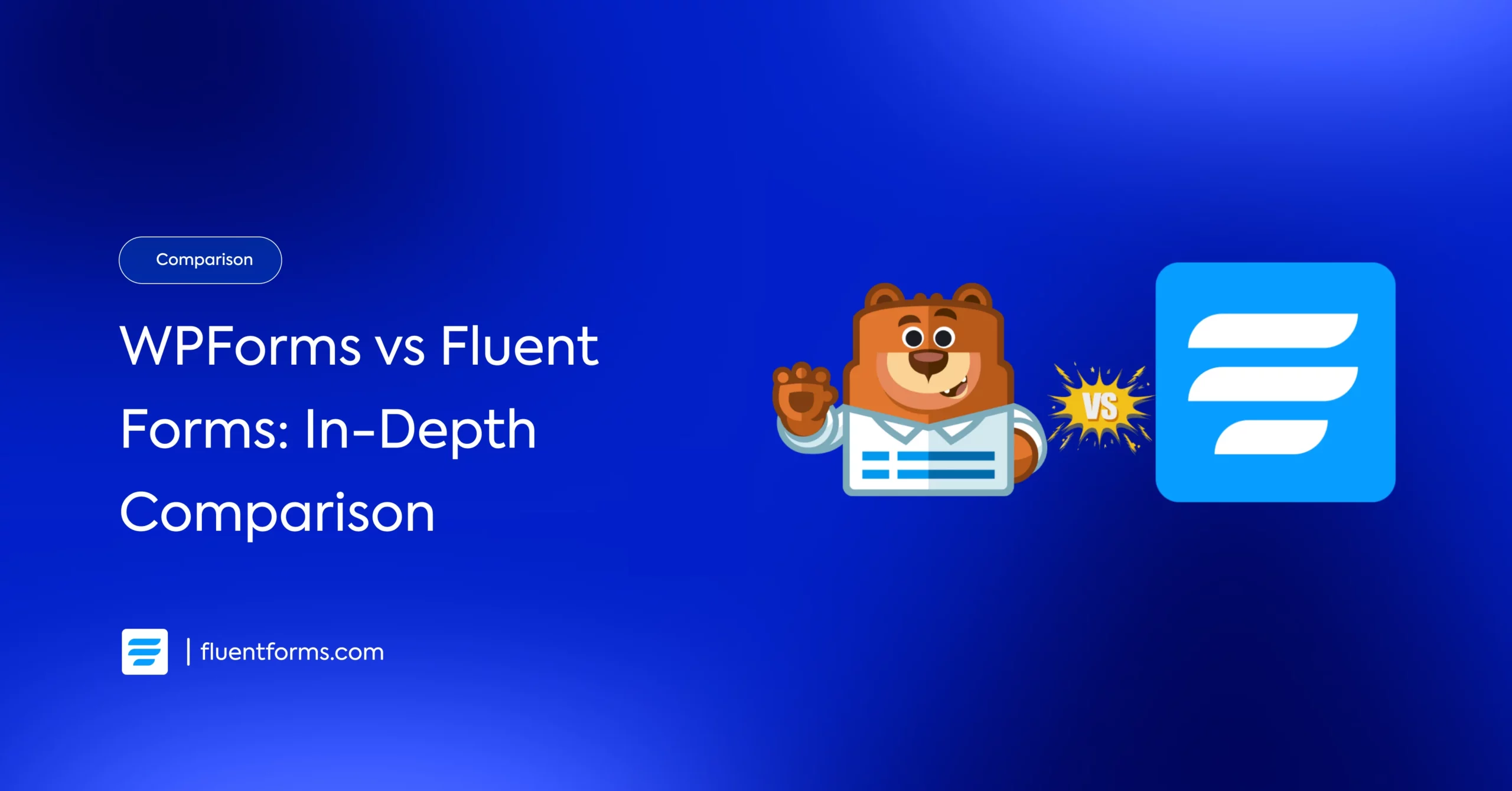
If you’re here, you’re probably facing the same question many WordPress users have asked:
Should I go with WPForms or is Fluent Forms a better deal?
In case you are a new user, let’s be clear about it, both the plugins have their own way of providing value. So, in this blog you’ll find that we’ve presented some metrics for you to become the judge and choose for yourself.
For the current WPForms users, it can also be the case that you’re frustrated with WPForms’ feature gating, or you’re just tired of switching between add-ons and upsells to build a decent form. Or perhaps you’re simply looking for the fastest, most cost-effective way to create smart forms on WordPress without hitting a wall.
Keep in mind that there’s no winner or loser in this comparison, it’s more of an honest feedback, where we also tried to go through the pain points of existing users as no single plugin can satisfy everyone in every case.
Let’s clear out any bias and jump into the comparison.
Why users are switching from WPForms
WPForms is widely known. It’s everywhere-from beginner tutorials to plugin roundups. But under the surface, there’s growing frustration:
- “The free version is too limited.”
- “You need Pro just for conditional logic.”
- “Basic payment integrations cost extra.”
The story repeats: Start with WPForms Lite, hit a wall, upgrade, then hit another paywall. Want form abandonment recovery? That’s a separate add-on. Want integrations? More add-ons. Want multi-step forms? Only available on higher tiers.
By the time you’re done stacking the features you actually need, that $99 plan becomes a $300+ annual investment.
What keeps WPForms popular
Despite the frustration, WPForms remains one of the most-used WordPress form plugins. And it’s not without reason.
WPForms strengths:
- Extremely beginner-friendly
- 2,000+ templates (across paid tiers)
- Clean drag-and-drop UI
- Tight integration with other WPBeginner products
- Good documentation and marketing
WPForms pricing (annual):
- Basic: $99/year (1 site)
- Plus: $199/year (3 sites)
- Pro: $399/year (5 sites)
- Elite: $599/year (unlimited)
That’s a steep climb just to unlock core functionality like payment support, conditional logic, and advanced integrations.
Fluent Forms: modern, lightweight, and built for users
Fluent Forms is catching attention-and fast. With over 600,000 active users and a five-star track record, it’s built for people who want powerful forms without bloated pricing.
What makes Fluent Forms stand out:
- Full-featured free version
- 60+ field types (25+ free fields)
- Conditional logic in the free plan
- Native conversational forms (free)
- Multi-column layout, AJAX, hCaptcha, Turnstile-all free
- Blazing fast UI, no reloads or slow load times
And the paid version? It’s just as generous.
Fluent Forms pricing (annual):
- Single Site: $79/year
- Agency (5 sites): $159/year
- Unlimited: $299/year (or $349 lifetime)
No confusing tiers. No add-on hunting. No nonsense.
Real-world feature matchups
Let’s break this down feature by feature:
Features | ||
Input Fields | 10 / 40+ | 25+ / 60+ |
Conditional logic | Pro only | Free + Pro |
Conversational forms | Paid add-on | Built-in (Free) |
Email Notification | Free + Pro | Free + Pro |
Multi-step forms | Pro+ tiers only | Pro |
Spam protection | Basic / Limited | reCAPTCHA, hCaptcha, Turnstile, CleanTalk |
Form templates | 2,000+ (mostly Pro) | 60+ (Free + Pro) |
Payment support | Pro+ tiers only | PayPal, Stripe, Razorpay (Pro) |
CRM & email integrations | Limited / tiered | 60+ native integrations (Pro) |
Frontend post submission | Pro only | Pro only |
PDF/Excel export | Pro only | Free + Pro |
Entry management | Limited in Free | Full dashboard (Free + Pro) |
Head-to-head comparison: where it really matters
Let’s go through the details of Fluent Forms VS WPForms comparison and find out where it makes both different from each other.
A closer look: UX and performance
WPForms
WPForms is clean. It also provides a visually pleasing interface. The form-building process starts with going to your WordPress dashboard>WPForms>Add New Form.
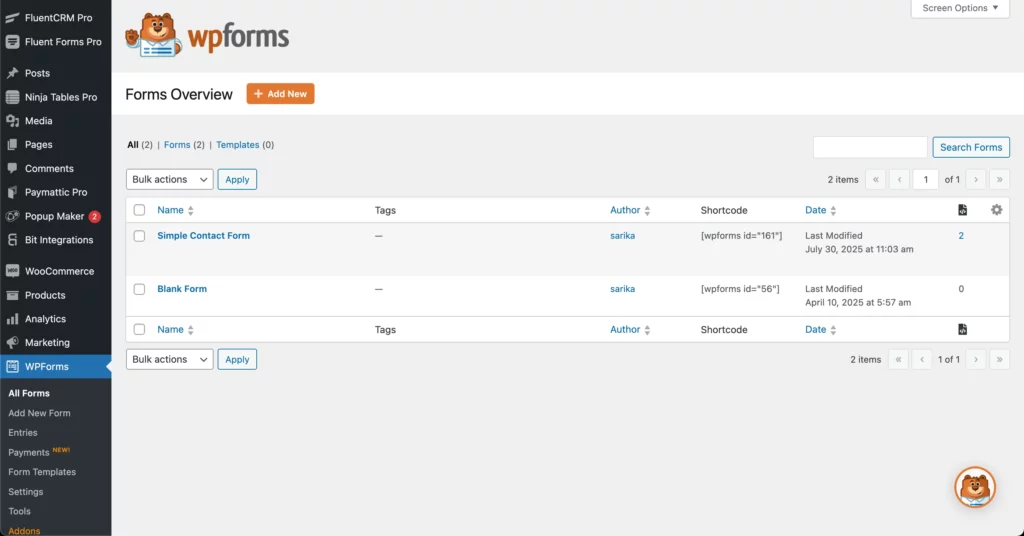
You can start with a blank form or choose from the available templates. There are a lot to choose from, but there’s more to it. We’ll talk about that in the template comparison section.
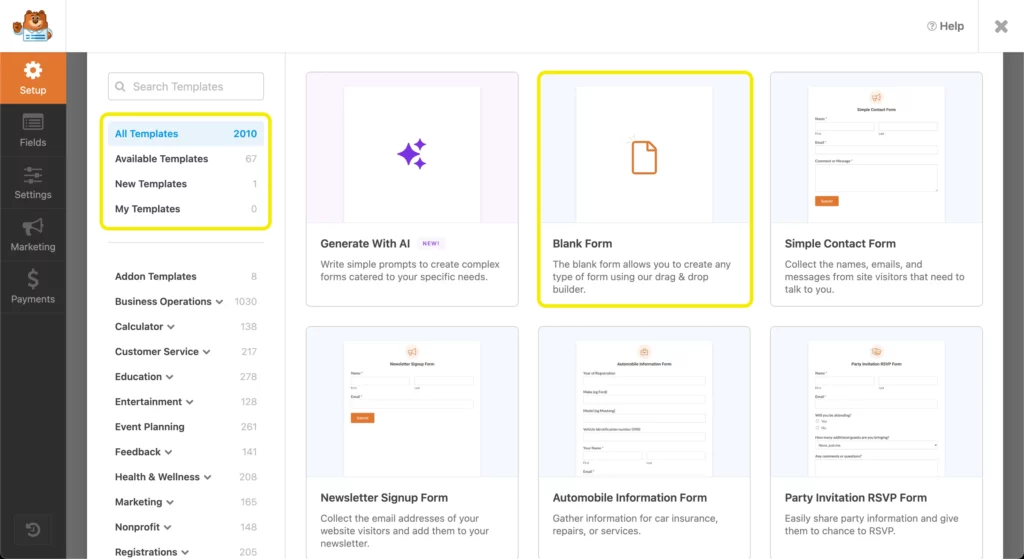
The form editor opens in a different screen, where you can’t access your WordPress dashboard. The editor interface is quite intuitive, but as your form grows, its interface can start to drag. Especially when loading advanced settings or conditional logic.
Also, the lag is visible when you try to click on the input fields, they aren’t instantly there for you. It takes several seconds to appear.
Customizing input fields is simple. For example, you can customize the Name field format.
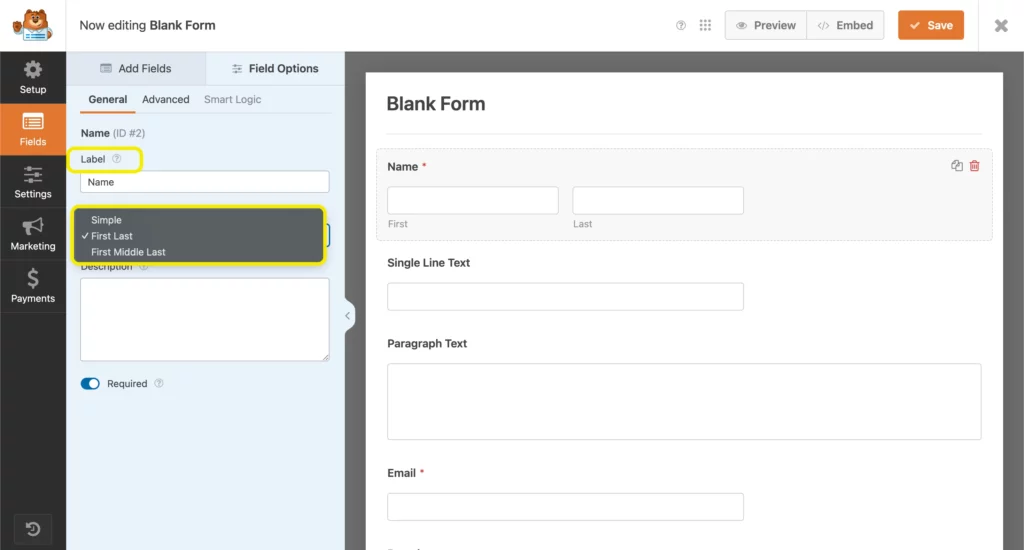
In the Advanced section, you can add CSS Class and modify the size of the field. There is also a Smart Logic option, which in Fluent Forms, is called Conditional Logic.
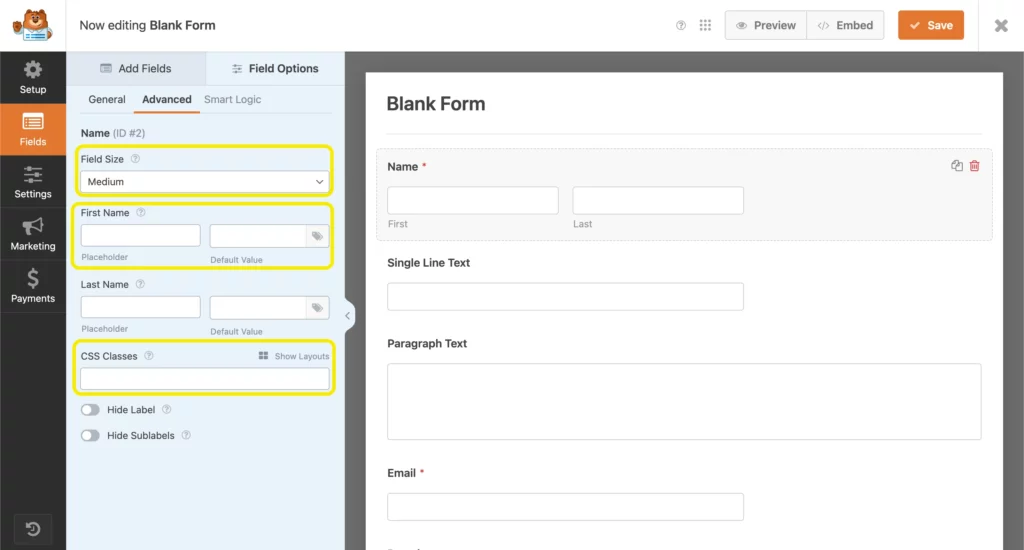
Fluent Forms
Fluent Forms is lean. It’s fast. No page reloads, no sluggish panels. Everything happens on one screen. To create a form, you can go to the WordPress dashboard, then to Fluent Forms.
Clicking on New form or Add New Form will let you create a new form.
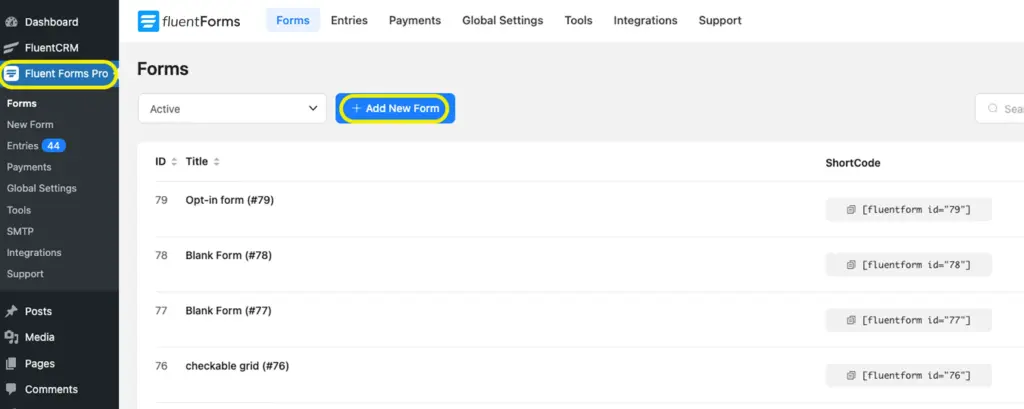
A pop-up appears and from there you can select the way you want to start. You have options to start from scratch, choose from the form templates, or use AI to create the form.
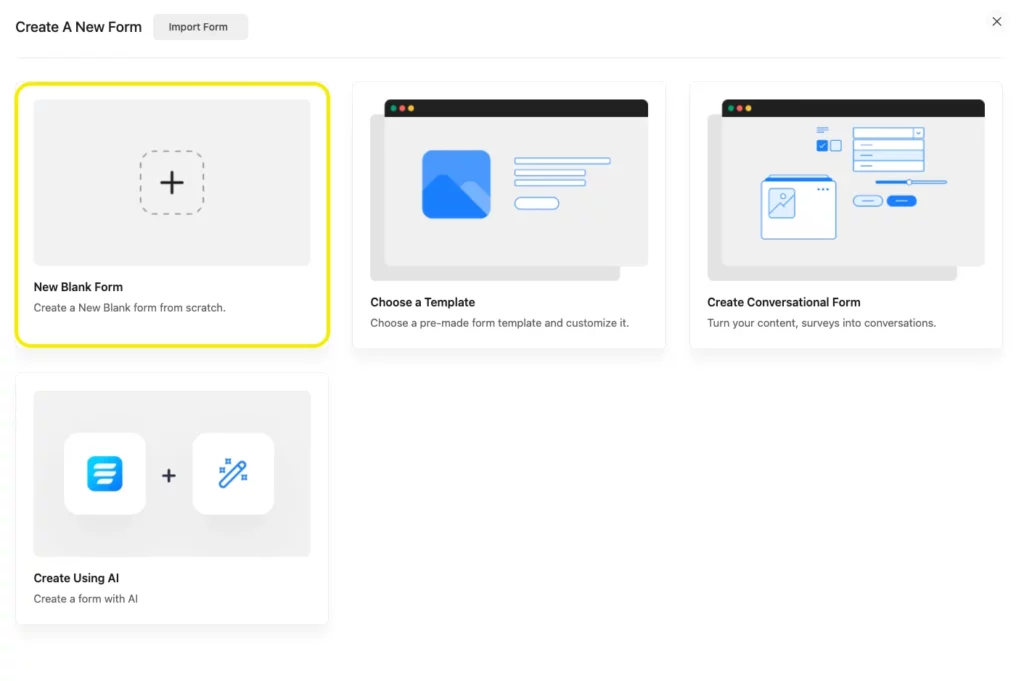
Choosing New Blank Form will lead you to a clean and simple interface, which is intuitive.
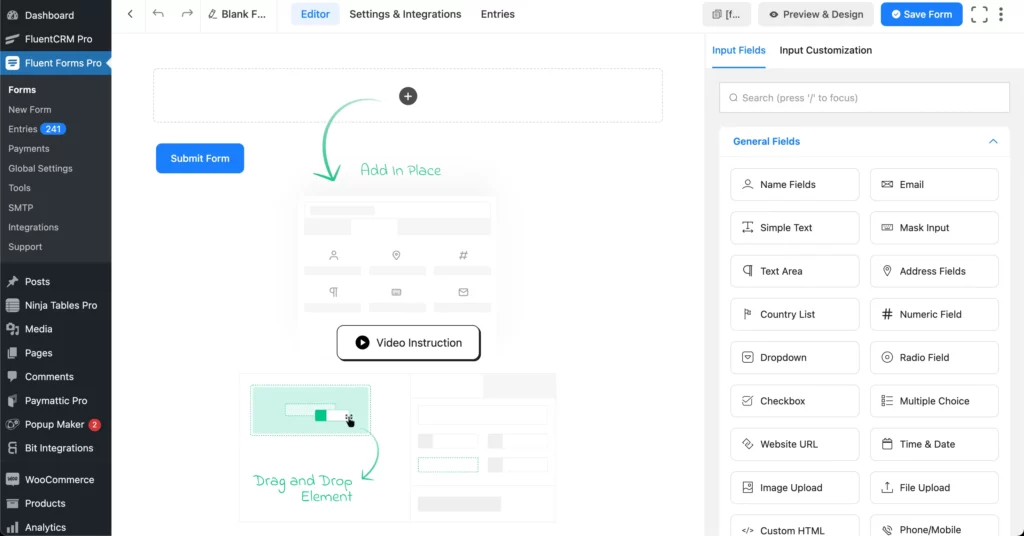
You can either click on the input fields, or drag them to create your form, it’s that easy.
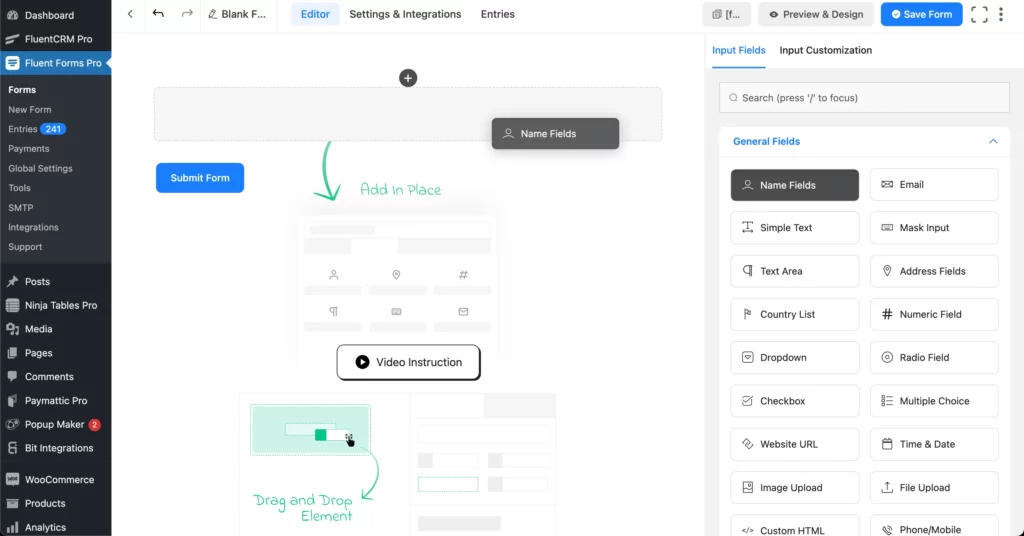
The developers of Fluent Forms care a lot about their users, and that’s why you never feel any lag while building a form. Here you can see that there’s no lag when you click on the input fields, they instantly appear.
Customizing input fields is also easy and intuitive. In this case, you can just tick the checkbox and the option is selected or deselected.
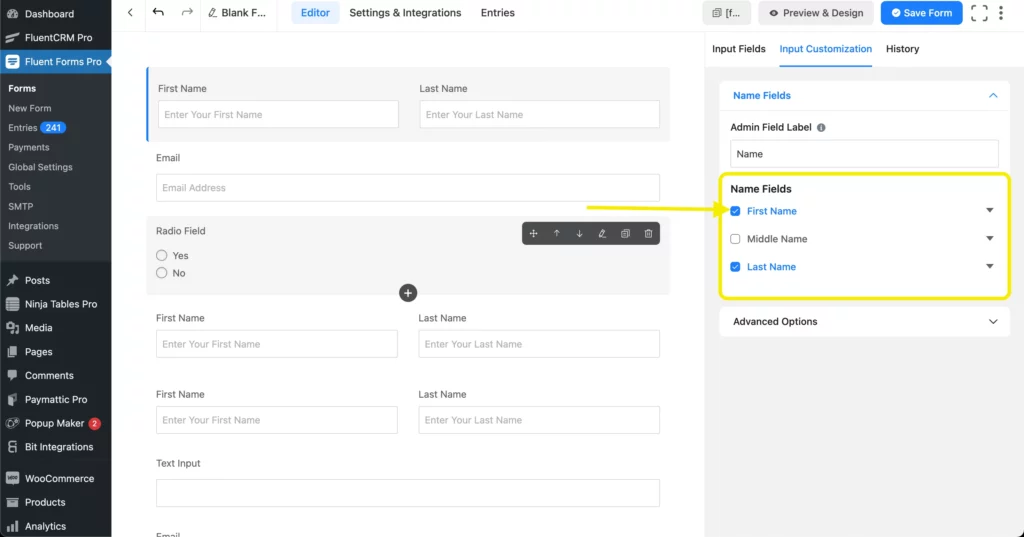
You can further customize them by clicking on those dropdowns.
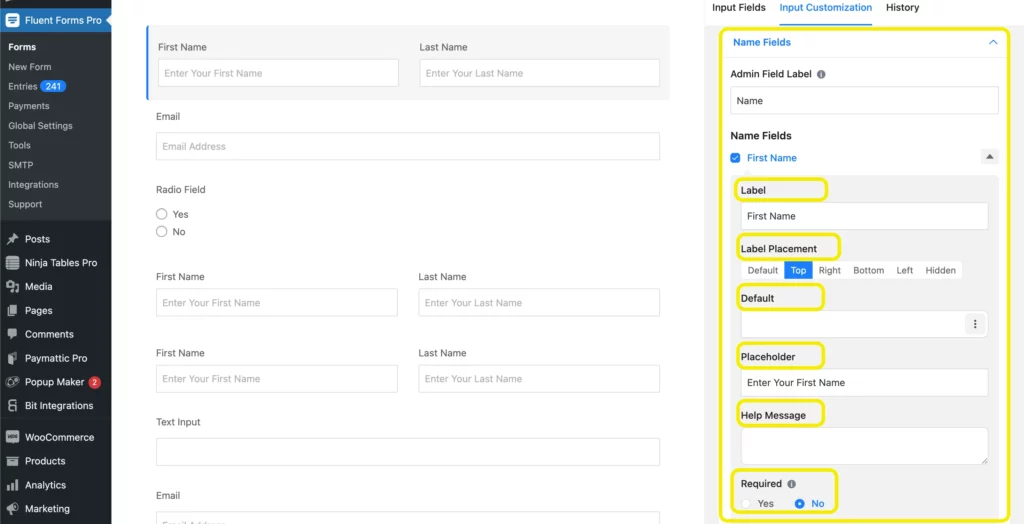
Accessing the Advanced Options is also easy, where you can find options like Container Class to design the element, Name Attribute to use them in calculation and other functions, and Conditional Logic to provide your form a touch of segmentation and personalization.
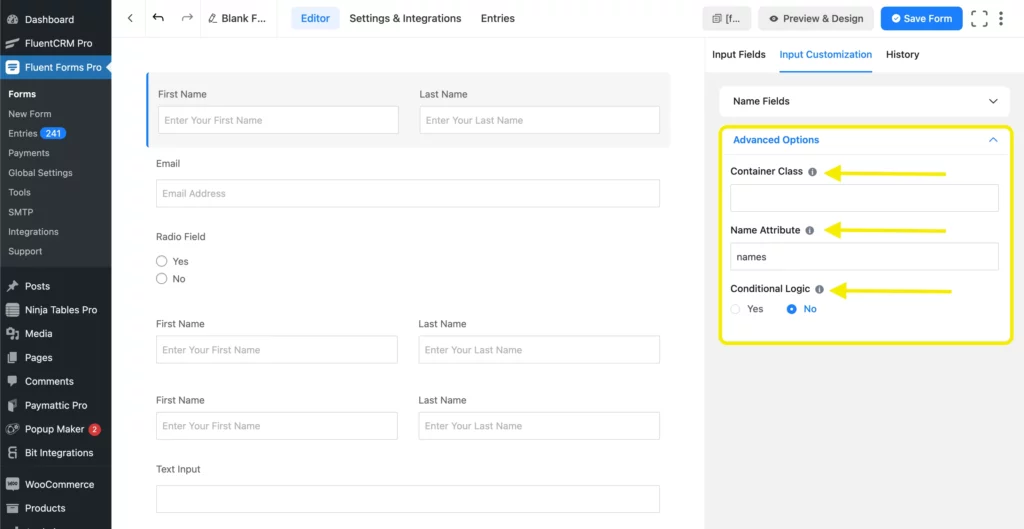
Form fields: how many fields you get
Fields are the heart of a form builder. Deciding upon a form builder can heavily depend on the variety of the fields and customization options that are available.
WPForms
It offers 40+ fields covering standard to advanced needs. But, only 18 fields in the free version.
Fluent Forms
Offers 60+ input fields in the pro version. Within this, 36 fields are available in the free version, which is twice the free versions offered by WPForms.
Both plugins have enough input fields to make any type of form you will need to run your business.
Form templates: build forms faster
When creating your first form, or when you need inspiration, a form template is good to have, and it saves a lot of time.
While buying a form builder, which one provides quality templates is a good question to ask.
WPForms
Starting with WPForms template collection, they have 2000+ form templates, and yes, the number is huge.
But they use repetitive form templates. A good thing is Custom Templates.
Let’s see how there are repetitive templates, that are actually one template, the only difference is the name of the template.
Drip Signup Contact Form Template-
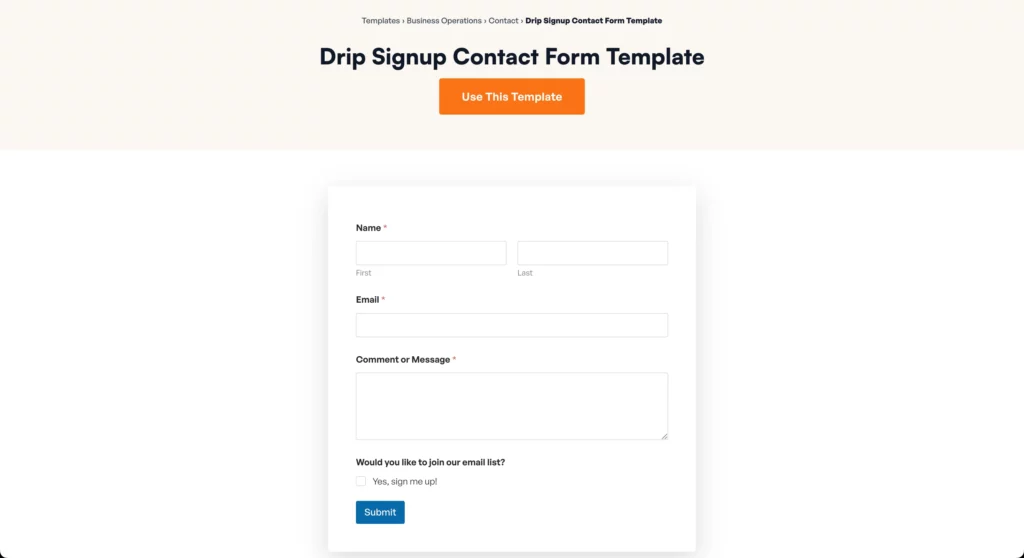
Mailchimp Signup Contact Form Template-
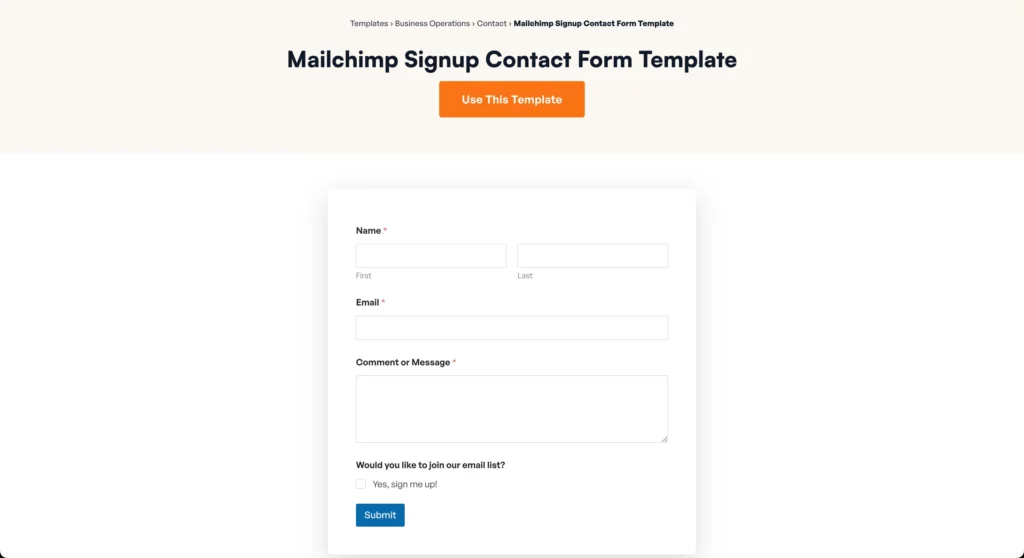
These two are actually one.
Is that a co-incidence? See it for yourself. Here’s some more.
PayPal or Credit Card Payment Form Template-
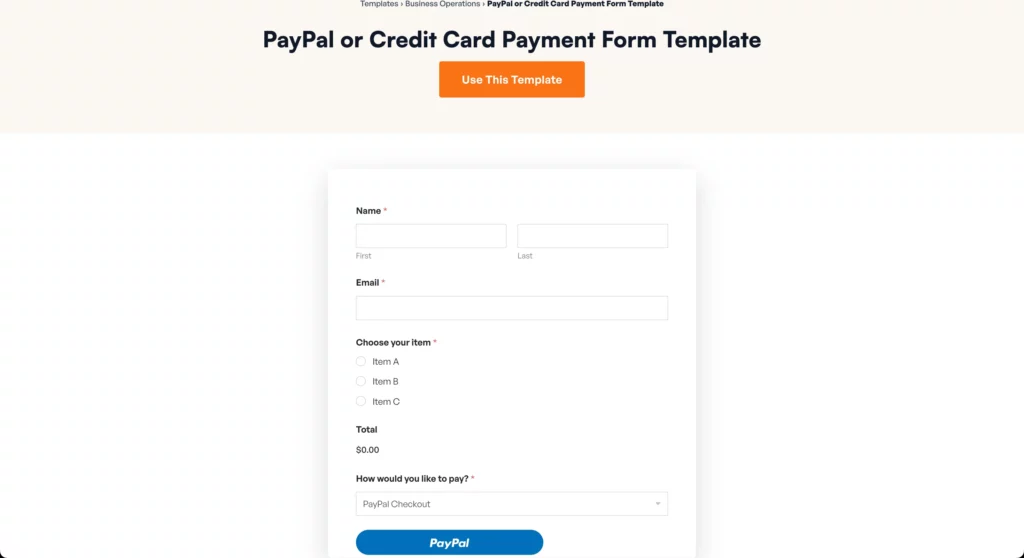
PayPal Payment Form Template-
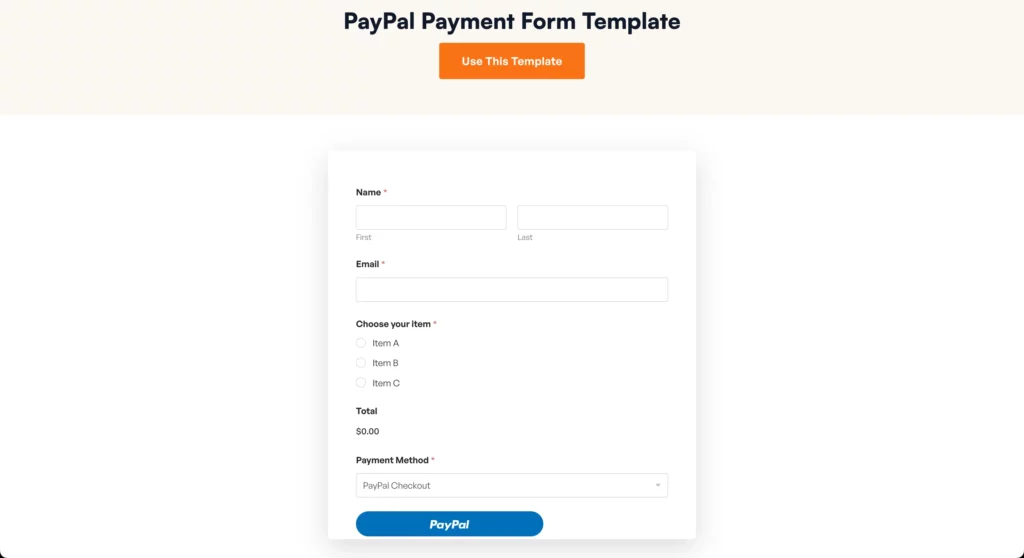
No dissimilarities between these templates. Now you do the math. It’s not a negative point, but if you’re only jumping in for the numbers, then you have to keep this in mind as well.
Fluent Forms
Fluent Forms has 70+ solid templates that cover all different use cases. They also have a lot of demo forms that are ready to download and use.
See how Fluent Forms has event-specific templates for different occasions.
A Valentine’s Day Dinner Reservation form, designed keeping in mind that including a surprise arrangement is a common gesture in those reservations-
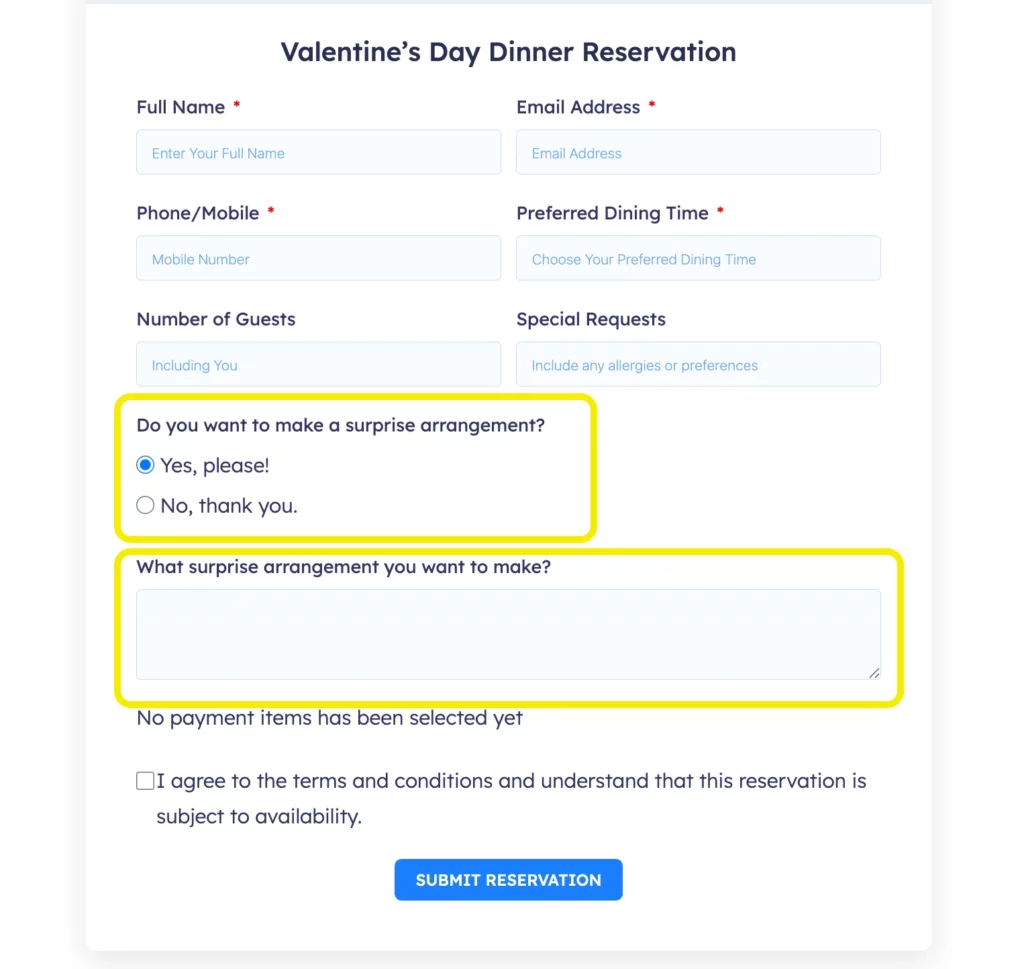
A Romantic Gateway template, targeting Valentine’s Day, keeping the vibe of the event-
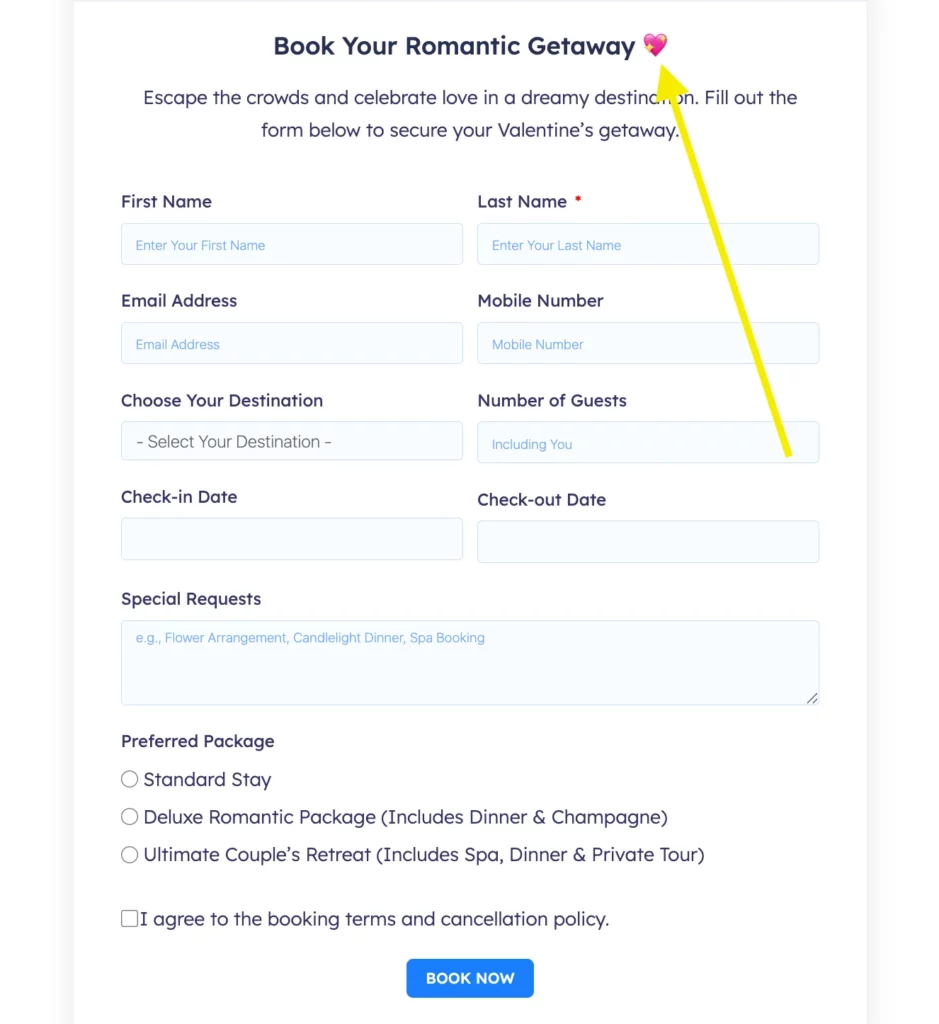
Even a simple RSVP form for party invitation is also available-
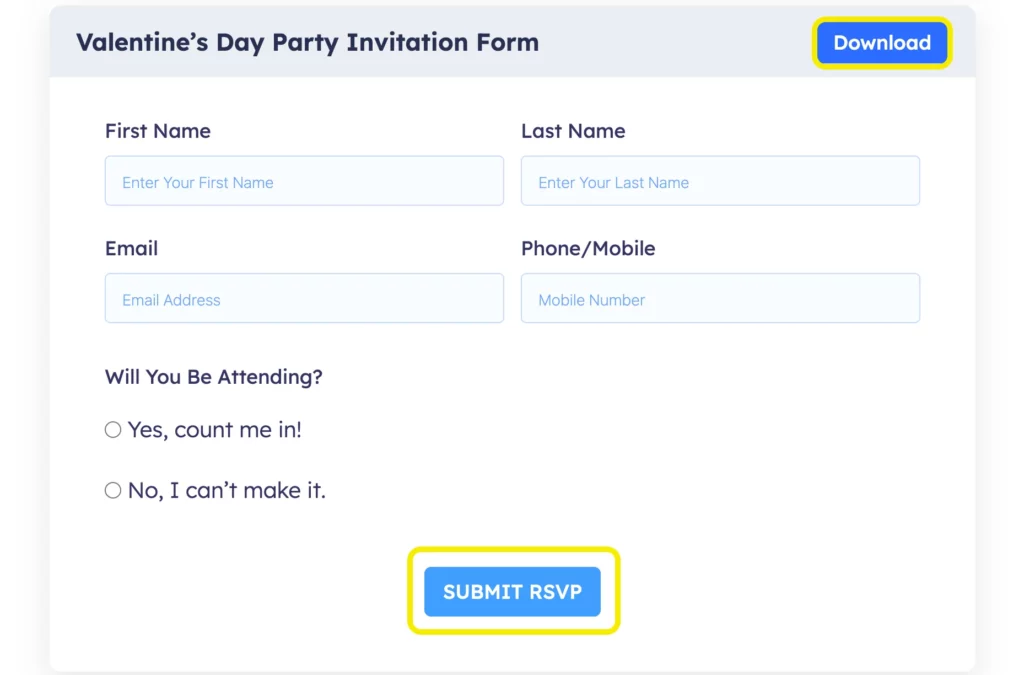
Now you can clearly understand how Fluent Forms has tailored templates to specific needs, having great quality, without worrying about the quantity.
Integration options: connecting your tools
Both plugins have all the necessary integrations in their arsenal.
Popular integrations regarding payment, email marketing, automation and others are available in both.
But the main factor in this case might be the ease of connection.
In the case of WPForms, they showcased 400+ integrations, but 250+ of them can only be added through Zapier (needs Zap premium), and 40+ only with Uncanny Automator.
Integrations that can only be connected by using Uncanny Automator, which also cost at least $149/year. Integrations through Zapier will also cost $180/year at least.
Fluent Forms Pro, comes up with 60+ integrations, and you can also connect 3000+ integrations with Zapier and Uncanny Automator. But most of the useful and popular integrations are available directly here.
Here are some notable integrations that can easily be connected with Fluent Forms Pro, directly without any added cost, whereas WPForms will cost quite a lot.
Integrations | ||
BuddyBoss | Third-party | Direct |
Discord | Third-party | Direct |
Telegram | Third-party | Direct |
Moosend | Third-party | Direct |
SendFox | Third-party | Direct |
ClickSend SMS | Third-party | Direct |
Form templates | Third-party | Direct |
Mautic | Third-party | Direct |
Insightly | Third-party | Direct |
Mollie | Third-party | Direct |
Notion | Third-party | Direct |
Form styling: designing forms your way
Yeah, we surely know that you want your forms to look good. We’ll talk about it as well. Let’s see which one does a better job when you’re trying to design your form.
WPForms
In WPForms, there is no styler within the form builder. You have to create a page, or add to an existing one. So you can’t just style a form before putting it on a page and then use it later.
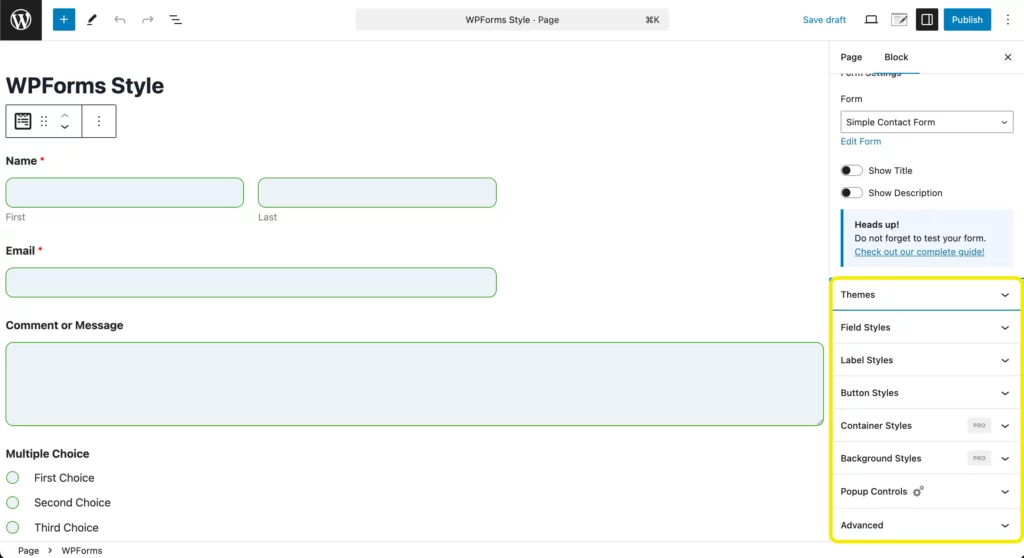
You can customize field styles, labels, button styles, containers, and backgrounds of your form.
The good thing about the styling is the themes, but it’s also in the block editor. In the free version, it’s not enough if you look closely because most of the palettes are locked behind the pro tier. But the good thing is that it is there to start with.
In case you need to copy the style of a form, you need to first copy the style code of the form and then paste it into the new one.
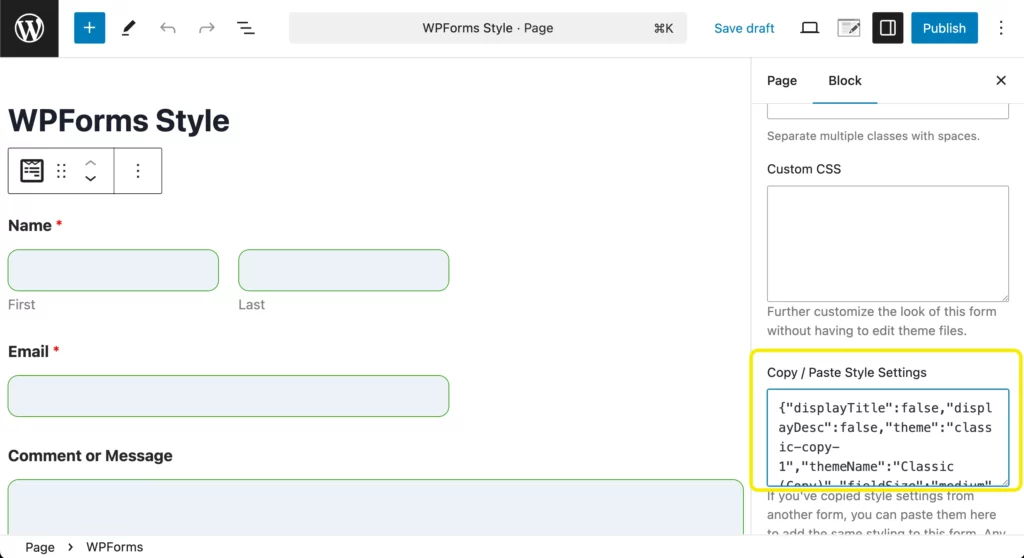
Fluent Forms
Advanced form styler (Pro) from Fluent Forms lets you design fast, within the preview section. No need to add this anywhere before deciding. You can design it and use it later.
In the general section, you can customize label styles, input & text area, placeholder, submit button style, etc.

Things like containers, asterisk, after submit success and error messages can be customized in the miscellaneous (misc) section.
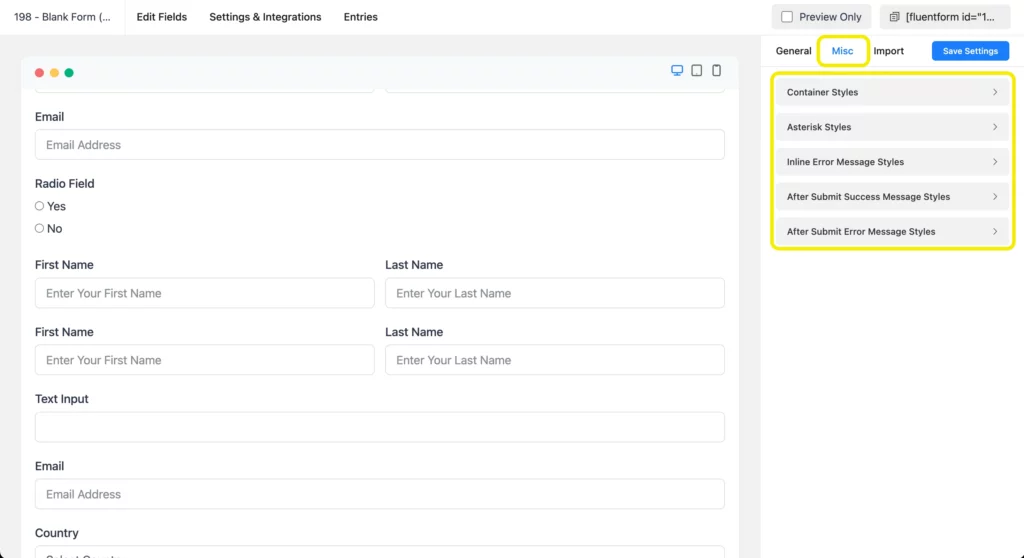
It might not have themes, but importing a design from a form JSON or an existing form is easy. You can add custom CSS to design forms as you like.
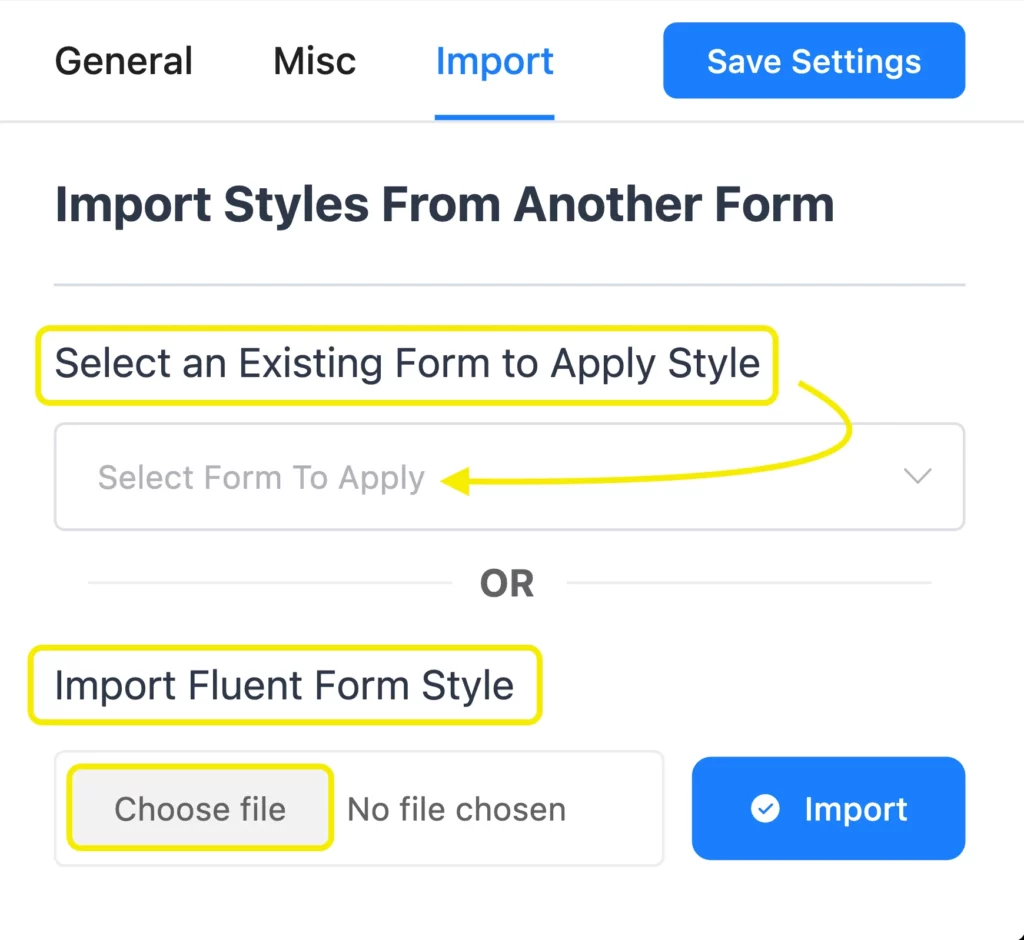
The style import feature is quite intuitive in Fluent Forms.
Security features: protect forms from spam
Securing your forms should be one of your top priorities. That’s why when choosing a form, checking out their security features is also what you should consider.
Here’s a list of security solutions offered by WPForms and Fluent Forms:
Custom Captcha is an advanced feature offered by WPForms that most small businesses won’t need to use, so you would not need to upgrade only for this feature.
Fluent Forms provides all of the form security features for free, and it’s more than enough to secure your forms. There are also various form restriction features for spam protection.
Support and documentation: how much help do you get
In terms of good support and good documentation, both plugins have quite a fair share.
WPForms stands out by giving Page Builder Support to basic users, and Multisite Support to the elite users.
But, in Fluent Forms, there’s no discrimination between the paid users and the free users, they all get priority support.
Both have over 4.8 out of 5-star reviews on WordPress.org. So, you can easily assume that these plugins are quite reliable when you’re asking for support.
A simple overview of the support channel and documentation available for both.
Support type | ||
Direct ticket support | ||
User documentation | ||
Developer documentation | ||
Community support forum | ||
Facebook group |
Fluent Forms also offers a dedicated community forum for forms enthusiasts, where Fluent Forms users can join and connect with other users. Users can share their findings, form design, form tutorials, ask others questions and help each other. This is a plus for everyone.
Pricing: which one can you afford
Let’s talk about money. Because at the end of the day, choosing the right form builder isn’t just about how many features you get. It’s about whether those features are actually worth what you’re paying.
Fluent Forms pricing keeps things simple. You get all core features – no matter which license you choose. Here’s the current pricing (before and after discount):
- Single site: $79/year
- Agency (5 sites): $159/year
- Unlimited sites: $299/year
For those looking for a one-time purchase, Fluent Forms also offers lifetime licenses – starting at $349. These licenses include updates and support forever, with no recurring fees. All plans give you access to advanced features like conditional logic, form scheduling, layouts, integrations, and advanced form styler – without add-ons or upsells.
WPForms, on the other hand, uses a more tiered system. The base plan starts at $99/year for one site and includes only the most basic features. If you want conditional logic, payment support, or CRM integrations, you’ll need to upgrade to Pro ($399/year) or Elite ($599/year). Even then, certain features like form abandonment, landing page mode, or surveys require add-ons.
Let’s break that down:
Pricing Plans | ||
Single site | $99 | $79 |
Mid-tier (5 sites) | $399 | $159 |
Unlimited | $599 | $299 |
Lifetime | Unavailable | Starting at $349 |
Fluent Forms is budget-friendly without sacrificing power. You won’t find surprise feature gates. You won’t be nudged toward a more expensive plan just to access form logic or use an integration. Even the free version includes more business-ready tools than most paid form plugins.
That said, WPForms isn’t a bad option – especially for those who want a familiar UI and a large library of templates. But when you weigh price vs features, Fluent Forms makes a stronger case for both new users and growing teams.
When WPForms still makes sense
To be fair, there’s no way we can say that ‘WPForms is a bad product’. It’s polished and works well for:
- Absolute beginners who just need a simple contact form
- Users deep into the WPBeginner ecosystem
- Teams that want tons of templates out of the box
But if you’re scaling or want more for your money, it’s hard to justify long-term.
When Fluent Forms is the better deal
Use Fluent Forms if:
- You care about speed and performance
- You want conditional logic, multi-column layout, spam protection – all without upgrading
- You want more value per dollar
- You’re building forms for clients and don’t want to pay $399 every year
Even Fluent Forms’ free version outperforms most paid form plugins. The pro version? It’s what other plugins charge 3x for.
Which free version feels enough: Fluent Forms vs WPForms
How to know if the free versions are enough?
To answer that, you’ll first need to know for whom the free version is. There are curious people, who just want to try out, but a great portion of new businesses try to save money every way possible. Let’s see which plugin’s free version can do the job nicely.
The comparison mostly depends on the type of forms that can be made and important features when someone is just starting their business, with no budget for a form builder. You feel that, right?
Take a glance of the input fields that are free in Fluent Forms, but pro in WPForms.
- Date n time
- Layout
- Custom Html
- Website URL
- Hidden Field
- Address
- Section break/ Section divider in WP
- Password field
If you need a layout for mobile optimization, you can’t have that in WPForms for free and it’s an important feature. You can’t create a booking form, where someone would not have to put the date manually, because the Date & Time field is in the pro version of WPForms.
Whereas, Fluent Forms provides some necessary input fields for free. Such as, you can create column layout with the Column Container, collect valid URLs with the URL field.
Custom HTML can be used in a form for branding, which is essential for new businesses with low budgets for developers; Fluent Forms have Custom HTML fields for free. It’s a flexible solution with more control.
Adding more to that, you can create login forms, as Password field also comes in the free package in Fluent Forms.
Another important thing to note is that you can create Conversational Forms for free, only in Fluent Forms. We all know that conversational forms are modern and more engaging, that’s why it’s an awesome feature to have without any cost.
Now, we admit that forms are not only about fields, there needs a lot of automation, and connection with other apps. In terms of integrations, Fluent Forms stands out, as we can get the popular email marketing integrations like Mailchimp, Slack for notifications, Stripe for payment, and WPML for translation.
Along with these, you also get access to the native integrations, which are popular plugins from WP Manage Ninja ecosystem.
Free native integrations in Fluent Forms:
- Fluent Support – Provide support
- FluentCRM – Email Marketing
- FluentSMTP – Email Deliveribility
- FluentCommunity – Community Plugin
- FluentBoards – Project Management
- Ninja Tables – Pricing/Comparison Tables
- FluentBooking – Scheduling
- WP Social Ninja – Review/Social feed
With all these integrations, you can
- Run email campaigns
- Provide support to your users
- Setup email deliverability,
- Create community
- Collect social reviews and showcase them on your site
- Track projects
- Schedule meetings with client
And many more.
In WPForms you also get some free integrations, but they don’t come like this as a package. That’s why you can clearly see that for a small business, with limited budget and capacity, Fluent Forms is self-sufficient.
Migration? easier than you’d think
In case you want to switch from WPForms, the process is also simple. Fluent Forms supports:
- WPForms to Fluent Forms import tools
- Easy field mapping
- Conditional logic conversion
- Entry migration with CSV
You won’t need to rebuild everything from scratch.
Final verdict: which form builder is worth your money
Both plugins have strengths. But if you’re paying for performance, flexibility, and modern features Fluent Forms gives you more for less.
Try Fluent Forms and WPForms for free, compare side-by-side. Then decide if WPForms is worth the extra hundred(s) for what Fluent Forms gives away in its free version.
Fluent Forms isn’t just an alternative. It might feel like an upgrade.
Need help switching from WPForms? Drop your questions in the comments and we’ll help you migrate smoothly.
Build Smarter Forms for Free










Leave a Reply